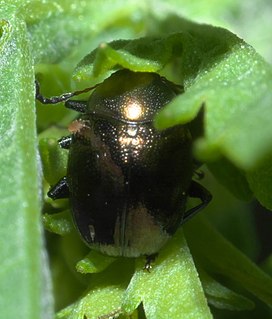
The Phalacridae are a family of beetles commonly called the shining flower beetles. They are often found in composite flowers. They are oval-shaped, usually tan, and about 2 mm in length.

The insects of the beetle family Chrysomelidae are commonly known as leaf beetles, and include over 37,000 species in more than 2,500 genera, making up one of the largest and most commonly encountered of all beetle families. Numerous subfamilies are recognized, but the precise taxonomy and systematics are likely to change with ongoing research.

The scarab beetle subfamily Scarabaeinae consists of species collectively called true dung beetles. Most of the beetles of this subfamily feed exclusively on dung. However, some may feed on decomposing matter including carrion, decaying fruits and fungi. Dung beetles can be placed into three structural guilds based on their method of dung processing namely rollers, dwellers and tunnelers Dung removal and burial by dung beetles result in ecological benefits such as soil aeration and fertilization; improved nutrient cycling and uptake by plants, increase in Pasture quality, biological control of pest flies and intestinal parasites and secondary seed dispersal. Well-known members include the genera Scarabaeus and Sisyphus, and Phanaeus vindex.

The Chrysomelinae are a subfamily of leaf beetles (Chrysomelidae). Some 2000 species are found, with worldwide distribution. The best-known member is the notorious Colorado potato beetle, an important agricultural pest.

The Lamprosomatinae are a small subfamily of leaf beetles (Chrysomelidae). They belong to the case-bearing Camptosomata.
Hygrobia is a genus of aquatic beetles native to Europe, North Africa, China and Australia. It is the only genus in the family Hygrobiidae, also known as the Paelobiidae. These are known commonly as squeak beetles or screech-beetles.

Phyllocharis ewani is a species of leaf beetle belonging to the family Chrysomelidae.

The Spilopyrinae are a small subfamily of the leaf beetles, or Chrysomelidae. They occur in Australia, New Guinea, New Caledonia and Chile. They were formerly considered a tribe of the subfamily Eumolpinae. The group was elevated to subfamily rank by C. A. M. Reid in 2000. However, some authors have criticised this placement, preferring to retain them within the Eumolpinae.

Calligrapha is a genus of large American Chrysomelinae of imprecise taxonomic boundaries. Most species occur in Central and South America.
Alfius is a genus of Chrysomelinae endemic to Queensland, Australia.

Eumolpini is a tribe of leaf beetles in the subfamily Eumolpinae. It is the largest tribe in the subfamily, with approximately 170 genera found worldwide. Members of the tribe almost always have a longitudinal median groove on the pygidium, which possibly helps to keep the elytra locked at rest. They also generally have a subglabrous body, as well as appendiculate pretarsal claws.
Epiphloeinae is a subfamily of checkered beetles in the family Cleridae. There are about 5 genera and at least 30 described species in Epiphloeinae.

Tarsosteninae is a subfamily of checkered beetles in the family Cleridae. There are at least two genera and two described species in Tarsosteninae.

Cheiloxena is a genus of leaf beetles in the subfamily Spilopyrinae. It is endemic to Australia, occurring from southern Victoria to central Queensland.
Macrolema is a genus of leaf beetles in the subfamily Spilopyrinae. It is found in Australia and New Guinea.
Allsortsia is a genus of leaf beetles in the subfamily Spilopyrinae. It contains only one species, Allsortsia maculata. It is found only in Australia, in the tropical rainforest of north Queensland.

Epimetopidae is a family of semi-aquatic beetles found on the edges of streams and shallow freshwater ponds. These beetles are shorter than half a centimeter long and have a pronotum with a central projection forming a shelf above the head. On the underside of the abdomen only four sternites are visible. There are less than a hundred species in three genera, Epimetopus which is restricted to the New World, mostly Neotropical, Eupotemus with two Afrotropical species and Eumetopus with some Oriental species. Females carry their eggcases on the underside of the abdomen.
2015 in paleoentomology is a list of new fossil insect taxa that were described during the year 2016, as well as other significant discoveries and events related to paleoentomology that were scheduled to occur during the year.
2015 in paleoentomology is a list of new fossil insect taxa that were described during the year 2015, as well as other significant discoveries and events related to paleoentomology that were scheduled to occur during the year.












